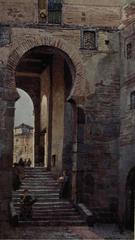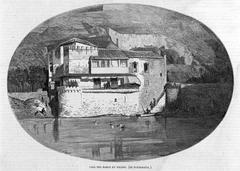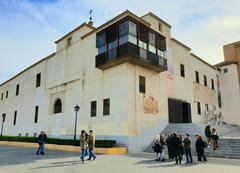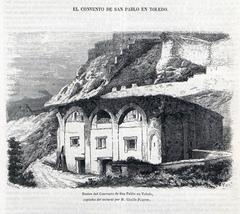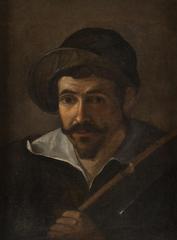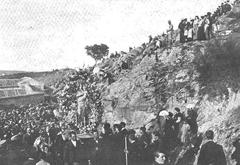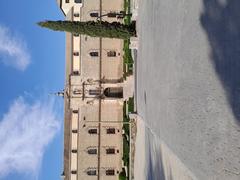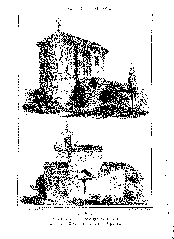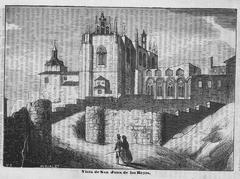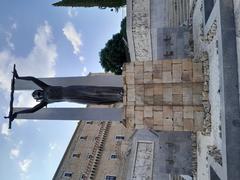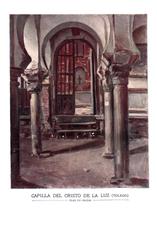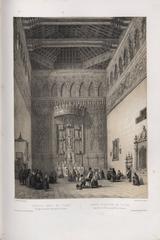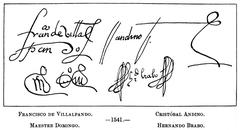Visiting Hours, Tickets, and History of Church of Santo Tomé in Toledo
Date: 16/08/2024
Introduction
Nestled in the historic heart of Toledo, Spain, the Church of Santo Tomé stands as a testament to the rich cultural and religious tapestry of the region. Originally built in the 12th century on the site of a former mosque, this iconic church has undergone various transformations, reflecting the city’s Islamic, Christian, and Jewish influences over the centuries (Wikipedia). Known for its stunning Mudéjar architecture, the church is also home to El Greco’s masterpiece ‘The Burial of the Count of Orgaz,’ which draws art enthusiasts from around the world (Britannica). This comprehensive guide aims to provide all the essential information for a memorable visit, including historical insights, ticket details, and practical tips. Whether you’re a history buff, an art lover, or a casual traveler, the Church of Santo Tomé offers a unique glimpse into Toledo’s multifaceted heritage.
Table of Contents
- [History and Significance](#history-and-significancehistory-and-significance)
- [Origins and Early History](#origins-and-early-historyorigins-and-early-history)
- [Rebuilding in the 14th Century](#rebuilding-in-the-14th-centuryrebuilding-in-the-14th-century)
- [Architectural Evolution](#architectural-evolutionarchitectural-evolution)
- [El Greco’s Masterpiece](#el-grecos-masterpieceel-grecos-masterpiece)
- [Cultural and Religious Significance](#cultural-and-religious-significancecultural-and-religious-significance)
- [Artistic and Architectural Highlights](#artistic-and-architectural-highlightsartistic-and-architectural-highlights)
- [The Mudéjar Tower](#the-mudéjar-towerthe-mudéjar-tower)
- [Contributions of Don Gonzalo Ruiz de Toledo](#contributions-of-don-gonzalo-ruiz-de-toledocontributions-of-don-gonzalo-ruiz-de-toledo)
- [The Church as a Museum](#the-church-as-a-museumthe-church-as-a-museum)
- [Visitor Experience](#visitor-experiencevisitor-experience)
- [Practical Information](#practical-informationpractical-information)
- [Detailed Ticket Purchasing Info](#detailed-ticket-purchasing-infodetailed-ticket-purchasing-info)
- [Travel Tips](#travel-tipstravel-tips)
- [Guided Tours and Special Events](#guided-tours-and-special-eventsguided-tours-and-special-events)
- [Tips for Photographers](#tips-for-photographerstips-for-photographers)
- [Accessibility Information](#accessibility-informationaccessibility-information)
- [FAQ](#faqfaq)
- [Conclusion](#conclusionconclusion)
History and Significance
Origins and Early History
The Church of Santo Tomé, located in the historical center of Toledo, Spain, has a rich and storied past that dates back to the 12th century. Initially constructed on the site of an 11th-century mosque, the church was founded after the reconquest of Toledo by King Alfonso VI of León (Wikipedia). The mosque, like many others in the city, was repurposed as a Christian church without significant alterations, reflecting the relatively peaceful transition of power during the reconquest.
Rebuilding in the 14th Century
By the early 14th century, the original structure had fallen into disrepair. Gonzalo Ruiz de Toledo, the Lord of Orgaz, took on the task of completely rebuilding the church. This reconstruction included transforming the old minaret of the mosque into a Mudéjar-style bell tower, a feature that still stands today (Itinerartis). The Mudéjar style, characterized by its Islamic influences, is evident in the tower’s horseshoe arches and intricate brickwork.
Architectural Evolution
Over the centuries, the Church of Santo Tomé has undergone several renovations and expansions, resulting in a harmonious blend of architectural styles. The exterior façade, completed in the 15th century, showcases intricate Plateresque ornamentation, while the interior features Gothic and Renaissance elements (InSpain). The church’s architectural evolution mirrors the broader historical and cultural shifts in Toledo, a city known for its diverse influences.
El Greco’s Masterpiece
The Church of Santo Tomé is perhaps best known for housing El Greco’s masterpiece, “The Burial of the Count of Orgaz.” This painting, commissioned in 1586, commemorates the death of Gonzalo Ruiz de Toledo, the church’s benefactor. According to legend, St. Augustine and St. Stephen descended from heaven to place his body in the tomb, a scene vividly depicted in the painting (Britannica). The artwork is divided into two parts, with heaven above and earth below, and features a striking use of color and elongated figures, hallmarks of El Greco’s style.
Cultural and Religious Significance
The Church of Santo Tomé holds a prominent place in Spanish history, having witnessed significant religious and cultural events throughout the ages. Its location within Toledo’s old Jewish quarter underscores the city’s historical role as a melting pot of different cultures and religions. The Jewish community, in particular, played a vital role in Toledo’s intellectual and economic prosperity (InSpain).
Artistic and Architectural Highlights
The church boasts an impressive array of architectural features that captivate visitors. The exterior showcases intricate stone carvings, delicate tracery, and soaring buttresses, reflecting the Gothic style prevalent at the time of its construction. Inside, visitors can marvel at ornate altars, stained glass windows, and vaulted ceilings, all testaments to the artistic prowess of Spanish craftsmen (InSpain).
The Mudéjar Tower
One of the most iconic features of the Church of Santo Tomé is its slender Mudéjar tower, visible from many parts of Toledo. The tower, which likely repurposed the old minaret, is a prime example of Mudéjar art, characterized by its use of brick and horseshoe arches (Toledo Monumental). The two upper sections of the tower feature groups of windows with pointed horseshoe arches, scalloped with other lobed arches, adding to its unique architectural charm.
Contributions of Don Gonzalo Ruiz de Toledo
Don Gonzalo Ruiz de Toledo, the Lord of Orgaz, played a crucial role in the church’s history. His contributions to the reconstruction in the 14th century are still evident today. The church’s two side naves with a flat chancel were added during this period, and the tower’s frieze of poly-lobed blind arches remains a distinctive feature (Toledo Monumental). His legacy is immortalized in El Greco’s painting, which continues to draw art lovers from around the world.
The Church as a Museum
In the 17th century, the naves were remodeled, and the entrance portico was refurbished. By 1972, the church had become a museum dedicated to El Greco, housing valuable sculptures such as the Virgen de la Sonrisa (Virgin of the Smile) and baroque figures from the 17th century, including a silver monstrance by Claudio Vegué (Toledo Monumental). This transformation into a museum has helped preserve the church’s artistic and historical treasures for future generations.
Visitor Experience
Today, the Church of Santo Tomé is one of the most visited tourist destinations in Toledo. Visitors can explore its rich history and architectural beauty while admiring El Greco’s masterpiece. The church is easily accessible from the city’s main square, the Plaza de Zocodover, making it a convenient stop for tourists (InSpain). The church’s location within the old Jewish quarter also offers visitors a chance to explore the broader historical and cultural context of Toledo.
Practical Information
Detailed Ticket Purchasing Info
Tickets can be purchased at the ticket office located directly across from the church’s main entrance. It is advisable to buy tickets early in the day to avoid long lines, especially during peak tourist seasons.
Travel Tips
- Best Times to Visit: Mornings are usually less crowded, making it an ideal time for a visit. Avoid weekends if possible, as they tend to be busier.
- Nearby Transportation Options: The church is within walking distance from Toledo’s main square, Plaza de Zocodover. Local buses and taxis are also readily available for those staying farther away.
Guided Tours and Special Events
Guided tours are available and provide in-depth information about the church’s history and architectural features. Special events, such as religious ceremonies and art exhibits, are occasionally held, adding to the visitor experience.
Tips for Photographers
Photography inside the church is generally allowed, but it is best to check for any restrictions. Early morning visits offer the best natural lighting for capturing the church’s stunning interiors.
Accessibility Information
The Church of Santo Tomé is committed to being accessible to all visitors. Ramps and handrails are available for those with mobility issues. It is recommended to contact the church in advance for specific accessibility needs.
FAQ
Q: What are the visiting hours for the Church of Santo Tomé?
A: The church is open Monday to Saturday from 10:00 am to 6:00 pm.
Q: How much are the tickets to visit the Church of Santo Tomé?
A: Tickets are priced at 4 €.
Q: Can I purchase tickets online?
A: Currently, tickets can only be purchased at the ticket office facing the main square.
Q: Are guided tours available?
A: Yes, guided tours are available and provide detailed information about the church’s history and architecture.
Q: Is the Church of Santo Tomé accessible for visitors with disabilities?
A: Yes, the church has ramps and handrails to accommodate visitors with mobility issues.
Conclusion
The Church of Santo Tomé is more than just a monument; it is a living piece of Toledo’s rich and diverse history. From its origins as a mosque to its transformation into a Christian church and later a museum, the church encapsulates the cultural and religious shifts that have shaped Toledo over the centuries. Its architectural beauty, marked by Mudéjar, Gothic, and Renaissance elements, and the artistic brilliance of El Greco’s ‘The Burial of the Count of Orgaz’ make it a must-visit destination (InSpain). Practical tips, such as visiting hours, ticket information, and accessibility features, ensure that your visit is smooth and enjoyable. As you explore this historic site, you’ll not only witness the architectural marvels but also gain a deeper understanding of the cultural and historical significance of Toledo. For more information and updates, be sure to check out other related posts, download the Audiala mobile app, and follow us on social media.
References
- Wikipedia. (n.d.). Church of Santo Tomé, Toledo. Retrieved from Wikipedia
- Itinerartis. (n.d.). The Church of Santo Tome in Toledo. Retrieved from Itinerartis
- InSpain. (n.d.). The Church of Santo Tome: El Greco’s ‘The Burial of the Count of Orgaz’. Retrieved from InSpain
- Britannica. (n.d.). The Burial of the Count of Orgaz. Retrieved from Britannica
- Toledo Monumental. (n.d.). Monument Santo Tome Church. Retrieved from Toledo Monumental
- The Geographical Cure. (n.d.). Santo Tome El Greco Burial of Count Orgaz. Retrieved from The Geographical Cure
- Spain.info. (n.d.). Church of Santo Tomé. Retrieved from Spain.info
- Toledo-Tourism. (n.d.). Church of Santo Tome. Retrieved from Toledo-Tourism
- Museo del Prado. (n.d.). The Burial of the Count of Orgaz. Retrieved from Museo del Prado
- Art and Architecture. (n.d.). Retrieved from Art and Architecture
- Toledo Guide. (n.d.). Retrieved from Toledo Guide
- Sacred Destinations. (n.d.). Toledo Church of Santo Tome. Retrieved from Sacred Destinations
- Spanish Nomad. (n.d.). One Day in Toledo Perfect Itinerary. Retrieved from Spanish Nomad
- Tourism Toledo. (n.d.). Santo Tome. Retrieved from Tourism Toledo
- Toledo Spain. (n.d.). 12 Monuments Not to be Missed. Retrieved from Toledo Spain
